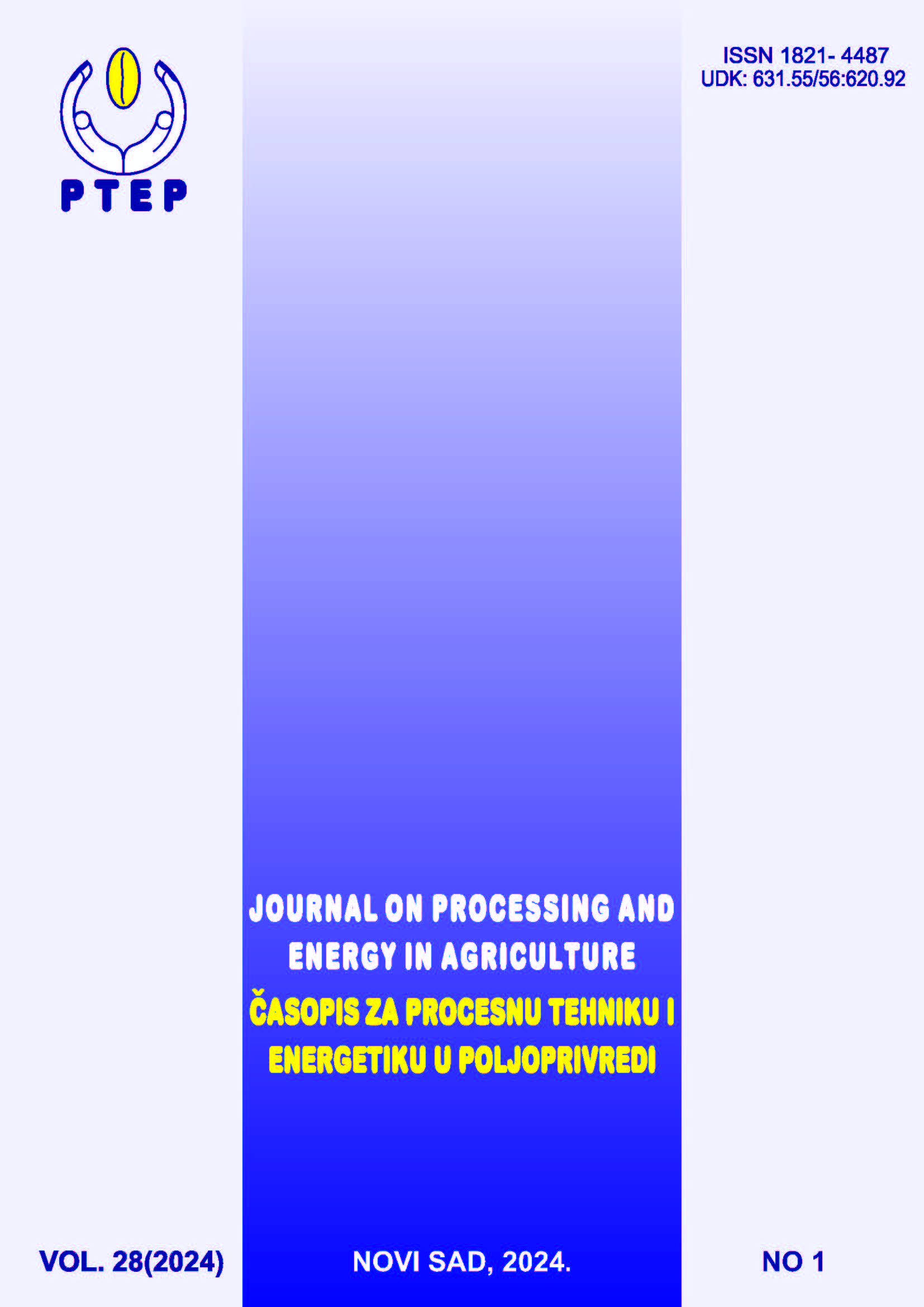DYNAMICS OF MOISTURE RELEASE FROM MAIZE HUSKS AS A FUNCTION OF CROP DENSITY
Abstract
Maize husk mass affects the dynamics of maize kernel moisture release as well as the yield and harvest timing of maize. This study aimed to observe the dynamics of moisture release in maize husks depending on the sowing density technology used. At the Zemu Polje location, a trail was established with three hybrids (H1-ZP 4708, H2-ZP4242, H3-ZP4790) in three densities (G1-40,816, G2-69,689, G3-89,286). During the vegetation period, 15 days after fertilization, four samples (V1-V4) were taken to determine the fresh and dry weight of the husk. The leaves were dried in an oven at 60°C for 12 hours. The effect of the genotype was reflected in the different masses of the maize husks and the dynamics of moisture loss. It was most pronounced in hybrid ZP 4242, which had the highest moisture loss between V1 and V4 samples at 9.86 %. It is also the hybrid with the highest fresh mass of leaves, 88.71 g. The dynamics of mass reduction, i.e. moisture loss, was linear in all hybrids, except for the exceptions by ZP 4242. The effects of sowing density and genotype on the moisture release of the maize husks and thus the maize kernel lead to an optimal harvest and a reduction in the risk of yield loss.
References
Jiang, S., Zhang, H., Ni, P., Yu, S., Dong, H., Zhang, A., & Cui, Z. (2020). Genome-wide association study dissects the genetic architecture of maize husk tightness. Frontiers in plant science, 11, 861.
Zhou, G., Hao, D., Chen, G., Lu, H., Shi, M., Mao, Y., et al. (2016). Genomewide association study of the husk number and weight in maize (Zea mays L.). Euphytica 210, 195–205. doi: 10.1007/s10681-016-1698-y
Gui-Hua, L., Chen, J. J., Xiu-Hong, X. U., & Guo, G. J. (2015). Genetic analysis and assessment of corn-husk traits of fresh-eating waxy corn. Acta Agriculturae Zhejiangensis, 27, 1122–1126. doi: 10.3969/j.issn.1004-1524.2015.07.02
Li, S., Zhang, C., Ming, L., Liu, W., & Li, X. (2014). Research development of kernel dehydration rate in maize. Mo. Plant Breed. 12, 825–829. doi: 10.13271/ j.mpb.012.000825
Cui, Z., Luo, J., Qi, C., Ruan, Y., Li, J., Zhang, A., et al. (2016). Genome-wide association study (GWAS) reveals the genetic architecture of four husk traits in maize. BMC Genomics, 17, 946. doi: 10.1186/s12864-016-3229-6
Zhou, G., Hao, D., Xue, L., Chen, G., Lu, H., Zhang, Z., Shi, M., Huang, X., & Mao, Y. ( 2018). Genome-wide association study of kernel moisture content at harvest stage in maize. Breeding Science, 68, 622–628.
Kang, M.S., & Zuber, M.S. (1989). Combining ability for grain moisture, husk moisture, and maturity in maize with yellow and white endosperms. Crop Science, 29, 689–692
Statistical Package SPSS 21, (version free of charge, IBM, Armonk, New York, USA).
Tabaković, M., Stanisavljević, R., Štrbanović, R., Poštić, D., & Sečanski, M. (2018). Disperzija osobina hibridnog semena kukuruza u odnosu na različite uslove proizvodnje. Journal on Processing and Energy in Agriculture, 22(1), 46-48. https://doi.org/10.5937/JPEA1801046T
hou, G., Mao, Y., Xue, L., Chen, G., Lu, H., Shi, M., ... & Hao, D. (2020). Genetic dissection of husk number and length across multiple environments and fine-mapping of a major-effect QTL for husk number in maize (Zea mays L.). The Crop Journal, 8(6), 1071-1080.
Wang, Y., Sheng, D., Hou, X., Zhang, P., Liu, X., Wang, P., & Huang, S. (2023). Positive response of maize husk traits for improving heat tolerance during flowering by alleviating husk inside temperature. Agricultural and Forest Meteorology, 335, 109455.
Suwa, R., Hakata, H., Hara, H., El-Shemy, H. A., Adu-Gyamfi, J. J., Nguyen, N. T., & Fujita, K. (2010). High temperature effects on photosynthate partitioning and sugar metabolism during ear expansion in maize (Zea mays L.) genotypes. Plant Physiology and Biochemistry, 48(2-3), 124-130.
Milašinović-Šeremešić, M., Radosavljević, M., Terzić, D., & Nikolić, V. (2018). Maize processing and utilisation technology: Achievements and prospects. Journal on Processing and Energy in Agriculture, 22(3), 113-116.
Bekrić, V., & Radosavljević, M. (2008). Savremeni pristupi upotrebe kukuruza. Časopis za procesnu tehniku i energetiku u poljoprivredi (PTEP), 12(3), 93-96.

